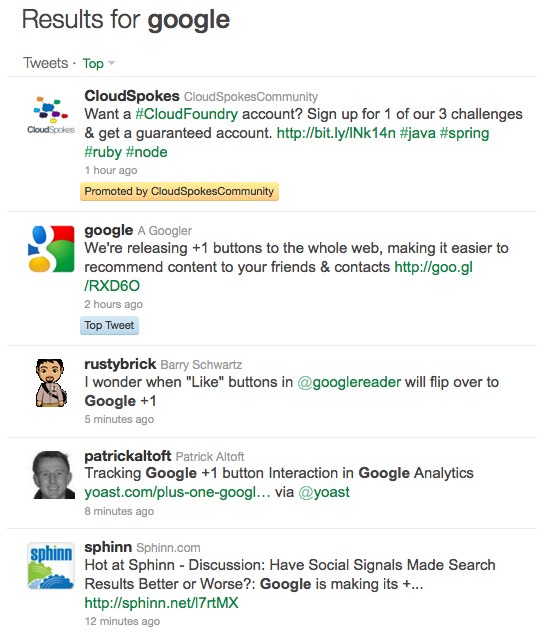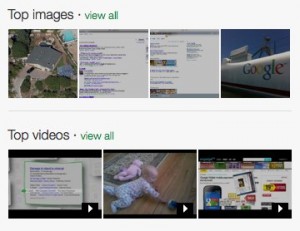Move Over Time Sorting: Twitter Gets “Top Tweets” Search Results
Twitter has added a new “Top Tweets” search results feature, along with “Top Images” and “Top Videos.” It’s a major shift away from showing Twitter search results where the most recent tweet comes first, regardless of real relevancy or quality. The change is welcome. Unlike regular search engines, which try to show the most relevant […]
Twitter has added a new “Top Tweets” search results feature, along with “Top Images” and “Top Videos.” It’s a major shift away from showing Twitter search results where the most recent tweet comes first, regardless of real relevancy or quality.
The change is welcome. Unlike regular search engines, which try to show the most relevant matches by default, Twitter has largely followed a “first in, last out” ordering of its search listings which left them open to noise.
Last year, Twitter experimented with improving relevancy by releasing “Top Tweets” into search results. Now — and somewhat confusingly — there’s a whole new type of “Top Tweets” that are available to Twitter searchers.
Three New “Top” Areas
Let’s take a look. Here’s an overview of the new search results screen you get from doing a search within Twitter.com:
The three arrows highlight the major changes. The first on the left is pointing from the new “Top” menu option to show the Top Tweets you get back by using this. The two on the right point to the new Top Images and Top Videos boxes. I’ll get back to those. But first, more on the Top Tweets.
Promoted Tweets, Top Tweets & New Top Tweets
Below is a close-up look at the search results I got after searching for google on Twitter, using the new default setting of “Top.”

The traditional Top Tweets are what are deemed especially popular over a long period of time, with “long” in Twitter terms meaning over a period of hours.
The unlabeled results after the “Promoted” and “Top Tweet” are the new Top Tweets that were released today. The results are those that are deemed interesting over a shorter period of time, say within the last hour.
The new Top Tweets are sort of like the old Top Tweets on steroids, giving anyone the chance to be relevant, the metaphorical 15 minutes of fame made real, versus the several hours of fame that a traditional Top Tweet might provide.
How About “Hot Tweets?”
Does your head hurt hearing about “old” or “traditional” Top Tweets versus “new” Top Tweets? Mine sure does. I wish Twitter had gone with another name for the new ones, such as “Popular” or “Hot.” In fact, I’m just going to unilaterally rename them “Hot Tweets” to keep from going insane, as I explain them more in this article.

Top gives you those “Hot” or relevant results I’ve talked about, while “All” gives you the traditional reverse chronological view.
Top/Hot Versus “All” Tweets
Here’s a side-by-side, with the new default of “Top” or what I call “Hot” tweets showing up, versus the “All” view:
First, look closely at the time stamps. The Hot Tweets are about one per minute apart. In contrast, the All tweets come every few seconds. Hot Tweets don’t show you everything.
That’s good, because next look at the content of the All tweets. All three tweets are exactly the same. There’s no value in seeing them. It’s just garbage, at worse; perhaps not interesting to many, in other cases.
The new default view helps ensure that if you do a search, you’re not getting overwhelmed by noise. It’s trying to pick out the more interesting tweets, though if you want to tune into everything, you can.
What’s Hot?
How does Twitter decide what’s most relevant, what should show up as a Top/Hot Tweet?
“Relevance for us today is using a combination of signals, your follower graph, who you follow, who’s following you. Another aspect is just looking at the content itself and the resonance of the content,” Mike Abbott, Twitter’s vice president of engineering who oversees search, told me.
Over at the Twitter engineering blog, there’s also more about the signals used, as well as how the results are personalized.
Personalized Results
Top/Hot Tweets are personalized for each individual? Yep. But for those worried that this means you’ll only see results from people you know, or only results you like, relax. The personalization isn’t that dramatic, Abbott says.
Indeed, Abbott showed me a screenshot of his own results for a search about a recently launched Twitter feature. The results showed some tweets that weren’t favorable about the feature, as well as those that were. So the personalized results aren’t just reinforcing what you like.
If you don’t want personalized results, you can log out of Twitter and search that way. Then you’ll get “normal” Top/Hot results, the company says.
Below, a side-by-side look of the personalized Top/Hot results I see versus the same search (for “google”) at the same time, when I was logged out:
On the left are my personalized Top/Hot results. Two of the top five results (tagged as “Me”) are results that are unique to me, based on people I’m more strongly connected with.
On the right are the generic Top/Hot results that everyone would see, if they searched logged out. There are two results unique there. (The “Most Relevant” heading has since changed to “Top”).
Three results are commonly shared. You’d see them whether you were logged in and getting personalized results or not. Obviously, the exact difference will vary depending on the searches you do. But the results aren’t completely personalized. There is some shared experience.
By the way, for those who really want to see alternative views, Twitter recently added a way for anyone to see how another person’s Twitter stream appears. See the story below for more about this:
Top Images & Top Videos

Until now, there’s been a compelling reason NOT to use Twitter for finding tweeted photos, as other services have offered a better experience. Our recent story below goes into more detail about that:
In the new feature, you can select an image or video to view it within Twitter, and there’s also context about the tweet that’s provided.
For example, in a search on “google,” a picture I recently tweeted is in Top Images. If you click on it, you see my picture, along with my tweet:
Twitter’s Own Picture Sharing Service
Related to Top Images, Twitter has also announced its own photo sharing service. It’s promised to rollout for everyone over the coming weeks. It’ll allow you to host images right on Twitter. Well, technically Photobucket will host them through a white label arrangement.
Why? In an interview at the D9 conference today, Twitter CEO Dick Costolo gave two key reasons:
- Make photo sharing easier
- Protect rights of those sharing photos
Apparently, some people find it hard to upload pictures to Twitter, Costolo said. He remarked that Howard Stern complained about this to Twitter cofounder Biz Stone, even.
Costolo spent more time talking about Twitter’s worry that some photo sharing services may be trying to lay copyright claims to photos uploaded to them. Twitpic seemed to be his main target, not surprising given recent changes to that company’s terms of service. For more on this, see our past story below:
Costolo stressed that Twitter wouldn’t be laying claim to anyone’s photos. Overall, I see it as a positive if it sets a higher bar that other services should meet. But I still want to see how it gets fully implemented.
Other Tidbits
There’s also the ability for Firefox users (with the right add-on or using the Firefox For Twitter edition) to type a Twitter username into the address bar and be taken right to that user’s page on Twitter. Hashtags also take you to hashtag search results.
Twitter has a video on the new features you can watch:
[youtube width=”560″ height=”349″]https://www.youtube.com/watch?v=fmB15ER3LUQ[/youtube]
How about some fresh stats? Twitter does about 1.6 billion searches per day now, the company tells me. It’s also seeing an increase in the number of human driven searches. It had been heavily dominated by automated ones, as the stories below explain more:
- The Twitter Search Landscape
- Twitter Does 19 Billion Searches Per Month, Beating Yahoo & Bing (Sort Of)
- Twitter Hits 1 Billion Queries Per Day, Announces New Search Tech
Finally, if you need more catch-up reading on how Twitter Search works in general, see our past article:
Contributing authors are invited to create content for Search Engine Land and are chosen for their expertise and contribution to the search community. Our contributors work under the oversight of the editorial staff and contributions are checked for quality and relevance to our readers. The opinions they express are their own.
Related stories



